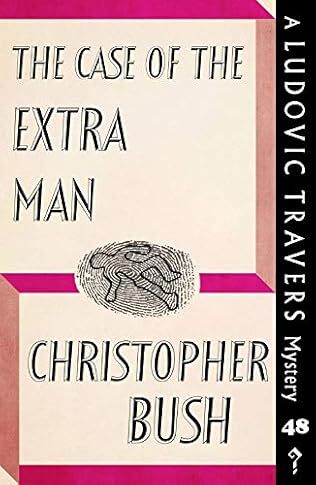The Case Of The Extra Man

A review of The Case of the Extra Man by Christopher Bush – 250219
There are some common themes running through Christopher Bush’s oeuvre such as resentment at the high level of British taxation, a fixation with women’s hair colouring, and the use of actors to establish a seemingly water-tight alibi, to name just a few. Added to the list is his dislike of crooners, first manifesting itself in The Case of the Housekeeper’s Hair and given full voice in this, the forty-eighth novel in his Ludovic Travers series, originally published in 1956 and reissued by Dean Street Press.
The husband of Travers’ client, Doris Bosford, made a living as a crooner until a throat problem forced him to look elsewhere for a source of income. This premature end to a show-biz career prompts Travers to remark, “it seemed to me that to qualify as a crooner one’s throat had to be in pretty bad shape from the outset”. Ouch.
Travers is still riding two horses, as Chairman and owner of the Broad Street Detective Agency and occasional consultant to the Yard, brought in to deal with the occasional ticklish case by his old sparring partner, George Wharton. These roles mean that occasionally Travers has to walk a fine line between preserving his own client’s confidentiality, the bedrock upon which his agency is founded, and being open and above board in his dealings with and his investigations on behalf of the police.
The potential for conflict in these two roles becomes clear as the Case of the Extra Man reaches its denouement and Travers, while knowing the truth about the demise of restaurateur, Dupont, written off by the police as a suicide, decides to keep quiet to protect a family member of his second client. With Travers as the narrator these conflicts of conscience and ethics come into sharper focus. Whether he made the right choice, though, is debatable.
The hallmark of a Christopher Bush is his ability to weave disparate strands into a satisfying whole. We have the disappearance of a husband, who seems to have found a lucrative source of income in the smuggling of goods, the discovery of a body washed up on the shore, a box under Doris Bosford’s bed which contains a lot of money, the rather over hasty identification of a corpse of which there is barely anything recognizable and the appearance of a mystery woman at the subsequent inquest.
Then we have the theft of some jewelry which Travers investigates on behalf of an insurance company, which brings Edward Cortin, his wife and Henry Calvert, Cortin’s brother-in-law, into the story followed by Cortin’s employment of Travers because of his concerns that his wife is being blackmailed. Of course, as the story progresses we see that these elements all knit together.
It is a tale of smuggling, double crossing and double identities, involving a very distinctive tattoo, which is over-inked to confuse identity – no laser surgery in those days – greed, and bigamy which leads to an attempt to cash in on that knowledge. There is more than a little coincidence and it was surely a mistake on the part of one of the culprits to reconstruct the very distinctive frontage of a restaurant in Dijon in an up-and-coming night spot in London, the Restaurant Club Antoine Dupont in Osbert Street, just off Jermyn Street. Naturally, Travers had been to the original in 1938 and a trip to Dijon, at the taxpayers’ expense, leads him to piecing together the identities of those involved and the identity of the extra man in the case.
Wharton and Travers seem to co-exist much better in what I found to be an enjoyable and entertaining story with Bush on top form.



